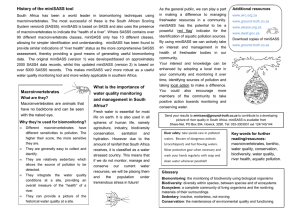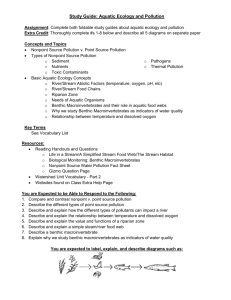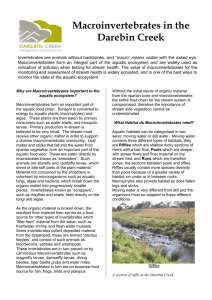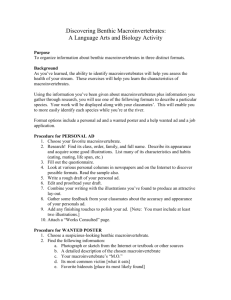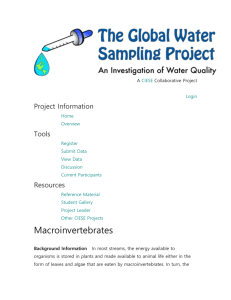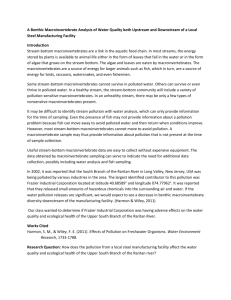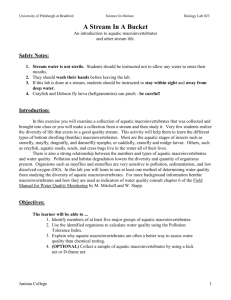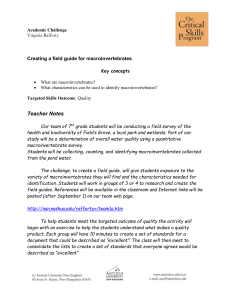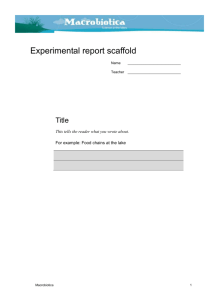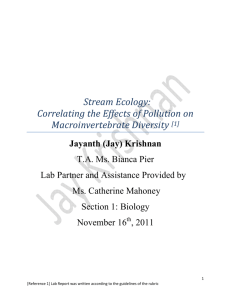Indicator Species
advertisement
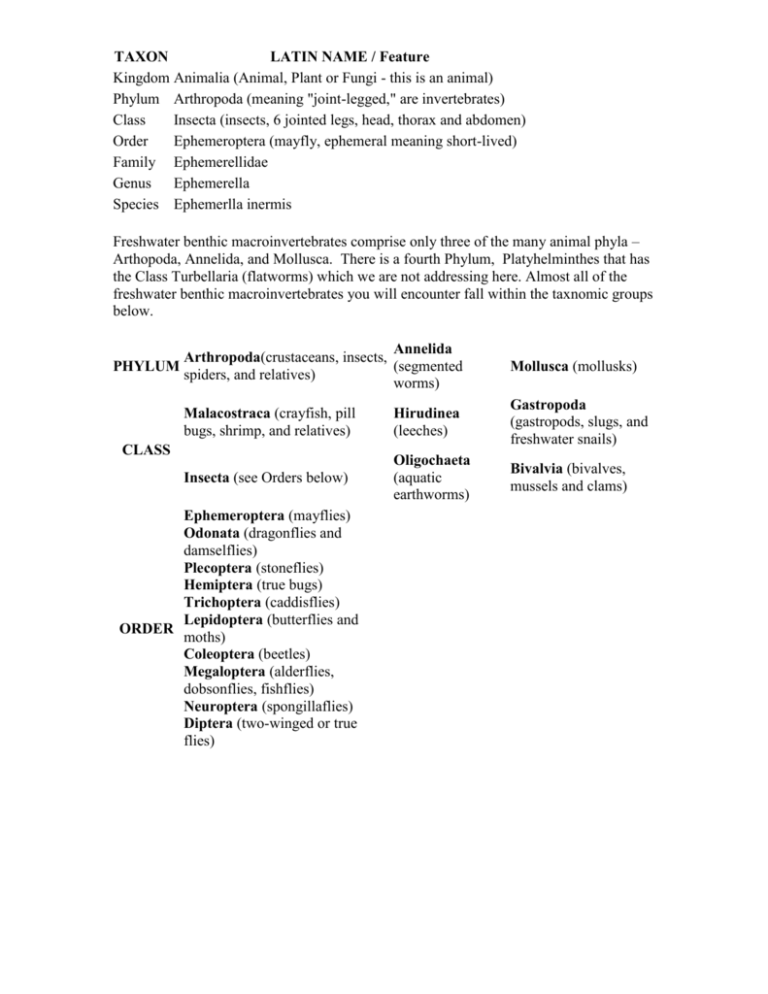
TAXON LATIN NAME / Feature Kingdom Animalia (Animal, Plant or Fungi - this is an animal) Phylum Arthropoda (meaning "joint-legged," are invertebrates) Class Insecta (insects, 6 jointed legs, head, thorax and abdomen) Order Ephemeroptera (mayfly, ephemeral meaning short-lived) Family Ephemerellidae Genus Ephemerella Species Ephemerlla inermis Freshwater benthic macroinvertebrates comprise only three of the many animal phyla – Arthopoda, Annelida, and Mollusca. There is a fourth Phylum, Platyhelminthes that has the Class Turbellaria (flatworms) which we are not addressing here. Almost all of the freshwater benthic macroinvertebrates you will encounter fall within the taxnomic groups below. PHYLUM Annelida Arthropoda(crustaceans, insects, (segmented spiders, and relatives) worms) Mollusca (mollusks) Malacostraca (crayfish, pill bugs, shrimp, and relatives) Hirudinea (leeches) Gastropoda (gastropods, slugs, and freshwater snails) Insecta (see Orders below) Oligochaeta (aquatic earthworms) Bivalvia (bivalves, mussels and clams) CLASS Ephemeroptera (mayflies) Odonata (dragonflies and damselflies) Plecoptera (stoneflies) Hemiptera (true bugs) Trichoptera (caddisflies) Lepidoptera (butterflies and ORDER moths) Coleoptera (beetles) Megaloptera (alderflies, dobsonflies, fishflies) Neuroptera (spongillaflies) Diptera (two-winged or true flies) Why Study the Stream-Bottom Macroinvertebrates? Stream-bottom macroinvertebrates are an important part of the community of life found in and around a stream. Stream-bottom macroinvertebrates are a link in the aquatic food chain. In most streams, the energy stored by plants is available to animal life either in the form of leaves that fall in the water or in the form of algae that grows on the stream bottom. The algae and leaves are eaten by macroinvertebrates. The macroinvertebrates are a source of energy for larger animals such as fish, which in turn, are a source of energy for birds, raccoons, watersnakes, and even fishermen. Stream-bottom macroinvertebrates differ in their sensitivity to water pollution. Some stream-bottom macroinvertebrates cannot survive in polluted water. Others can survive or even thrive in polluted water. In a healthy stream, the streambottom community will include a variety of pollution-sensitive macroinvertebrates. In an unhealthy stream, there may be only a few types of nonsensitve macroinvertebrates present. Stream-bottom macroinvertebrates provide information about the quality of a stream over long periods of time. It may be difficult to identify stream pollution with water analysis, which can only provide information for the time of sampling. Even the presence of fish may not provide information about a pollution problem because fish can move away to avoid polluted water and then return when conditions improve. However, most stream-bottom macroinvertebrates cannot move to avoid pollution. A macroinvertebrate sample may thus provide information about pollution that is not present at the time of sample collection. Stream-bottom macroinvertebrates are relatively easy to collect. Useful stream-bottom macroinvertebrate data are easy to collect without expensive equipment. The data obtained by macroinvertebrate sampling can serve to indicate the need for additional data collection, possibly including water analysis and fish sampling. Indicator Species Biological indicator species are unique environmental indicators as they offer a signal of the biological condition in a watershed. Using bioindicators as an early warning of pollution or degradation in an ecosystem can help sustain critical resources. While indicator species is a term that is often used, it is somewhat inaccurate. Indicators are actually groups or types of biological resources that can be used to assess environmental condition. Within each group, individual species can be used to calculate metrics such as percent Achnanthes minutissima (a diatom species) or groups of species (e.g., EPT taxa) or individual orders (e.g., Caddisfly larvae - Order Trichoptera) in an effort to assess water quality conditions. The major groups include: Fish Invertebrates Periphyton Macrophytes Marine environments also utilize biological indicators. While this site focuses predominately on freshwater resources, marine/tidal indicators are also quite important in sustaining biodiversity and preserving and restoring marine and estuarine resources. Macroinvertebrates That Are Sensitive to Pollution Found in Good Quality Water Stonefly Riffle Beetle Adult Gilled Snail Planarian Mayfly Water Penny Caddisfly Hellgramite Macroinvertebrates That Are Somewhat Sensitive to Pollution Found in Good or Fair Quality Water Crayfish Alderfly Crane Fly Riffle Beetle Larva Damselfly Sowbug Dragonfly Watersnipe Fly Scud Whirligig Beetle Larva Fishfly Clam or Mussel Macroinvertebrates That Are Tolerant of Pollution Found in Any Quality Water Aquatic Worm Lunged Snail Black Fly Leech Midge Fly
